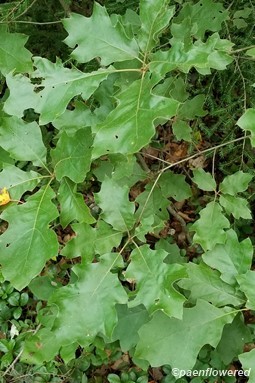Quercus velutina
Quercus velutina black oak
This species of oak is very similar in overall appearance to the Northern red oak. Both species are large trees and have big leaves with moderate-sized lobes and pointed tips. During most of the spring and summer you have to look for fine details to tell the difference.
The black oak has clusters of small hairs on the underside of the leaves, particularly at the junction of veins or along the main vein. The red oak lacks these hairs. The buds of the black oak are covered with dense grey hairs and sharply angled, while those of the red oak are hairless and not angled. The bark of the black oak is dark and blocky in appearance, usually, but not always without shiny ridges. The red oak also has dark bark, but it is furrowed and often laced with broad shiny strips. There are also minor differences in the shape of the acorns. In autumn the distinction becomes more obvious.
The red oak can turn deep red, while the black oak may briefly show a tinge of yellow or orange, but quickly turns brown. Both oaks may retain many of their leaves through the winter. The black oak is not a major contributor to fall coloration in the forests of Western Pennsylvania.
Habitat & Range
Common in dry woods.
Present throughout the state except most northern counties.
| EMP: | UPL |
|---|---|
| NCNE: | UPL |
Phenology
Flowers in spring.
Similar Species
Quercus rubra - leaves are similar, but are more boat-like in shape (widest in the middle) while black oak's are widest half way to the top. Black oak has clusters of small hairs on the underside of the leaves which red oak does not.
Plant Codes
S-rank: S5 (Secure)
G-rank: G5 (Secure)


















Comments
Have you spotted this plant in your area? We'd love to hear about your experience! Share your comments or questions about the plant below. Comments are moderated before posting.